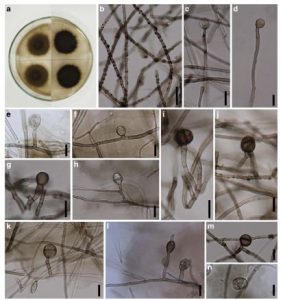Neooccultibambusa chiangraiensis Doilom & K.D.Hyde, sp. nov. Index Fungorum number: IF551967
Etymology: Name refers to the province which the fungus was collected.
Holotype: MFLU 15–3531
Saprobic on dead twigs of T. grandis. Sexual morph: Ascomata (250–)345–355(−400) μm high × (230–)245–295(−325) μm diam. (x = 325 × 265μm n = 10), black, solitary to gregarious, scattered, immersed to semi-immersed through bark fissures, when cut horizontally locules visible with white contents, uniloculate, globose to subglobose, with a central ostiole. Ostiole 110–200μm high, 100–130μm wide, circular, central, periphyses. Peridium 25–50μm thick, composed of textura angularis cells, comprising two layers, outer layer; black, thick-walled, inner layer; hyaline, thin-walled. Hamathecium 1.5–2.9 μm wide hyphae-like, filiform, septate, numerous, cellular pseudoparaphyses, embedded in a gelatinous matrix. Asci (70–)115 − 160(−207) × 14–21 μm (x = 128 × 20 μm n = 20), 8-spored, bitunicate, cylindrical to subcylindrical, with a short furcate to rounded pedicel, or sometime long pedicel, apically rounded, with an ocular chamber. Ascospores (33–)36–37(−43) × 8–13 μm (x = 37 × 10 μm n = 20), overlapping biseriate, hyaline when young and 1-septate, surrounded by a gelatinous sheath, when mature, pale brown, fusoid, with narrowly rounded ends, constricted at the center septum, slightly constricted at all septa, with 1–3 transverse septa, swollen at the center, smooth, with small and large guttules, surrounded by mucilaginous sheath. Asexual morph: forms chlamydospores in culture.
Culture characteristics: Ascospores germinating on PDA within 24 h. Germ tubes produced at both ends of ascospores. Colonies on MEA reaching 7–12, 10–15 and 13–17 mm diam. after 7, 10 and 21 days respectively in the dark at 25 °C (x = 8.8, 11 and 14.8 mm for 7, 10 and 21 days respectively, n = 5), circular, convex or dome-shaped, cottony, aerial in the center, immersed at the edge, edge entire, dense, after 10 days colonies brownish grey (5F2), radially striated with lobated edge. Mycelium 2–3μm wide, aerial to immersed, pale brown to dark brown, septate, branched hyphae, septate, slightly constricted at septa, some melanin deposits. Chlamydospores (7.5–) 12–14 (−16) × (8.5–) 12–14 (−17) (x = 12 × 11.8μm n = 20), produced from immersed mycelia, initially subglobose with 1 cell, hyaline with 1-septate, becoming pale brown to dark brown.
Habitat: Known to inhabit dead twigs of T. grandis (current study).
Known distribution: Thailand (current study).
Material examined: THAILAND, Chiang Rai Province, Muang District, Mae khon Subdistrict, on dead twigs of T.grandis, 8 September 2012, M. Doilom, (MFLU 15–3531, holotype), ex-type living culture MFLUCC 12–0559, MKT 075, ICMP 21165, GenBank Accession No: ITS: KU712442, LSU: KU764699, SSU: KU712458, TEF1: KU872761.
Notes: Neooccultibambusa is introduced as a new genus in the family Occultibambusaceae with N. chiangraiensis as the type species. The new genus is similar to Occultibambusa in having dark brown, fusiform ascospores surrounded by a gelatinous sheath, but Neooccultibambusa produces cylindrical to subcylindrical asci, ascospores with 1–3 transverse septa. Occultibambusa produces broadly cylindrical to clavate asci and ascospores with 1 transverse septum.
FIG Morphology of Neooccultibambusa chiangraiensis on media. a Colony on PDA after 5 days from single spore isolation. b Mycelia with melanin deposits. c–m Chlamydospores produced on mycelia. n Chlamydospores. Notes: b–n Morphology on MEA. Scale bars: b, k = 20 μm, c–j = 10 μm, g–h, l–n = 10 μm
